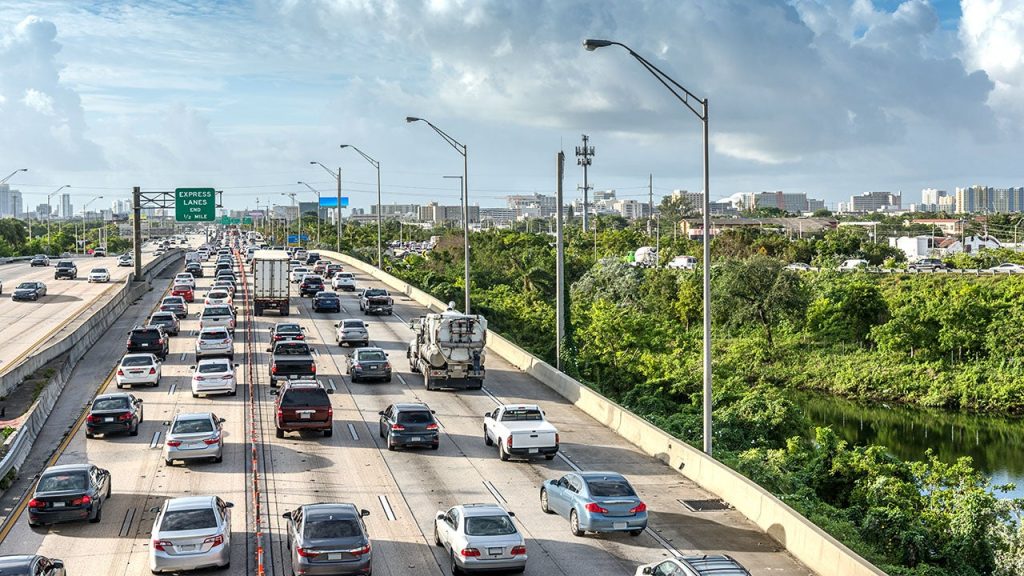Florida is already one of the most expensive states for car insurance, and drivers who are considered high-risk often pay the most for coverage. Drivers with DUIs, speeding tickets or other infractions are usually placed in a high-risk group along with people who live in congested or crime-ridden areas, teens and drivers with poor credit. Although you can control some of these factors, others are out of your hands. We analyzed the latest average rates along with various third-party data on customer experience and financial stability to help you find the best high-risk auto insurance in Florida based on your personal factors.
High-risk car insurance rates in Florida
According to data analyzed from Quadrant Information Services, the average Florida driver pays $4,151 per year for full coverage car insurance and $1,118 for minimum coverage car insurance as of April 2025. What you pay could be much different.
Generally, car insurance companies use about a dozen different rating factors to determine your premium. Of these factors, your driving record is one of the most significant. Usually, a conviction or accident of any type (even a not-at-fault accident) can cause your premium to increase. However, certain kinds of driving activity may impact your premium more than others.
Below, we’ve listed some of the most common high-risk scenarios that increase average Florida car insurance premiums. We’ve included average premiums for some of the largest car insurance companies by market share in the state to give you an idea of how rates vary between carriers. It is important to note that your other rating factors will also influence your premiums, and some of the listed carriers may not be willing to extend coverage to certain high-risk drivers.
Rates after a speeding ticket in Florida
Although speeding tickets are fairly common, you’ll usually see an increase in your car insurance premium after a speeding conviction. In Florida, average rates for full coverage jump to $4,829 per year.
How much your rate goes up after a speeding ticket in Florida can vary. Generally, the faster you were going over the speed limit, the more severe the infraction. The more severe the infraction, the more your premium might go up. Where you were speeding — in a school or construction zone, for instance — can also play a part.
Insurance companies also rate different factors in different ways. Companies that are the cheapest prior to a violation are sometimes the most expensive afterwards. Other companies might increase rates for people who take advantage of discounts or safe driving programs. The best way to find the cheapest rate for you is to shop around and get multiple car insurance quotes.
| Car insurance company | Florida premium before a speeding ticket* | Florida premium after a speeding ticket* | Percentage difference |
|---|---|---|---|
| Farmers | $3,771 | $4,081 | 8% |
| Geico | $4,243 | $5,461 | 29% |
| Progressive | $5,443 | $7,221 | 33% |
| State Farm | $3,046 | $3,547 | 16% |
| *All rates are average annual full coverage rates. |
Rates after an accident
The details of your accident will typically determine how significantly your premium will increase, but the average Florida driver pays $5,613 per year for full coverage car insurance after causing an accident. If your insurance provider had to pay out a lot in property damage, multiple people were injured, the accident occurred in a work zone or you were caught driving under the influence, for instance, you are likely to see a higher spike in premium. Your insurance provider will also consider your prior driving history — if you have a history of frequent driving infractions, you might face a steeper premium increase or could even be denied coverage by certain insurers.
| Car insurance company | Florida premium before an accident* | Florida premium after an accident* | Percentage difference |
|---|---|---|---|
| Farmers | $3,771 | $5,209 | 38% |
| Geico | $4,243 | $5,418 | 28% |
| Progressive | $5,443 | $8,172 | 50% |
| State Farm | $3,046 | $4,096 | 34% |
| *All rates are average annual full coverage rates. |
Rates after a DUI in Florida
A DUI conviction is among the most severe infractions a driver can have on their driving record. In fact, some companies may refuse to sell a policy to a driver convicted of a DUI. Although the average rates below could provide a helpful baseline, you may want to contact companies directly if you have a DUI on your record to see if you qualify for coverage. The average Florida driver’s annual full coverage premium spikes to $6,145 after a DUI conviction.
In addition to increased premiums, the state of Florida will also likely require you to carry a certificate of financial responsibility called an FR-44 after a DUI conviction. Although the FR-44 itself won’t cause your premium to go up (outside of the filing fee), the liability limits required for one are much higher than those required of most Florida drivers, which will increase your minimum coverage car insurance costs.
| Car insurance company | Florida premium before a DUI* | Florida premium after a DUI* | Percentage difference |
|---|---|---|---|
| Direct Auto | $6,134 | $6,514 | 6% |
| Farmers | $3,771 | $7,111 | 89% |
| Geico | $4,243 | $6,305 | 49% |
| Progressive | $5,443 | $6,187 | 14% |
| *All rates are average annual full coverage rates. |
Rates for drivers with bad credit
Some states ban or restrict car insurance companies from using your credit-based insurance score to calculate your rate, but not Florida. This means that Floridians can expect their credit history to have an impact on how much they pay for coverage. The average Florida driver can expect to pay around $8,312 per year for full coverage insurance—significantly higher than those convicted of a DUI.
Statistics show that drivers with poor credit file more claims than drivers with good or excellent credit. To compensate for this heightened risk, car insurance companies typically charge drivers in the poor credit tier some of the highest rates.
| Car insurance company | Florida premium for a driver with good credit* | Florida premium for a driver with poor credit* | Percentage difference |
|---|---|---|---|
| Allstate | $3,954 | $7,313 | 85% |
| Farmers | $3,771 | $7,787 | 106% |
| Geico | $4,243 | $7,310 | 72% |
| Progressive | $5,443 | $9,582 | 76% |
| *All rates are average annual full coverage rates. |
Rates after a lapse in coverage
Driving without insurance in Florida is illegal. If you have a lapse of car insurance in Florida, the state could suspend your license and force you to carry an FR-44. You might also be deemed a high-risk driver and see an increase in your average premium (although this can depend on your prior driving history and may vary from company to company).
Legality aside, car insurance provides vital financial protection. Comparing rates to find the most robust policy that you can fit into your budget could save you from devastating out-of-pocket expenses if you cause an accident without sufficient coverage. It might also save you from paying the higher rates that come after a coverage lapse—about $4,786 per year for full coverage Florida car insurance.
| Car insurance company | Florida premium before a coverage lapse* | Florida premium after after coverage lapse* | Percentage Difference |
|---|---|---|---|
| Farmers | $3,771 | $4,515 | 20% |
| Geico | $4,243 | $4,284 | 1% |
| Progressive | $5,443 | $5,713 | 5% |
| State Farm | $3,046 | $3,088 | 1% |
| *All rates are average annual full coverage rates. |
Rates for teen drivers
Being a safe driver doesn’t happen overnight. It takes time and experience to develop strong defensive driving skills. Teens are new to the road and tend to engage in more risky driving behavior, such as distracted driving, speeding and not wearing a seat belt. As a result, car insurance companies usually place drivers under the age of 25 in the high-risk auto insurance category and price their policies accordingly. In Florida specifically, adding a 16-year-old to their married parents policy increases average full coverage rates to $8,182 per year, up from $3,994 per year for married Florida parents without kids on their policy.
Many companies offer a variety of teen driver discounts, such as good student, away at school and drivers training to help parents defray expensive car insurance costs. Nonetheless, the best thing you can do is ensure your teenager learns good driving habits so their driving record stays clean (and so they stay safe). Comparing rates from multiple companies could also help you save some money.
| Car insurance company | Florida premium for married parents without child | Florida premium for married parents & 16-year-old* | Percentage Difference |
|---|---|---|---|
| Allstate | $3,674 | $5,894 | 60% |
| Farmers | $3,467 | $8,806 | 154% |
| Geico | $4,217 | $8,124 | 93% |
| Progressive | $5,311 | $8,532 | 61% |
| *All rates are average annual full coverage rates. |
Who is a high-risk driver?
A high risk driver is typically someone who has one or more of the following:
- Speeding tickets
- At-fault accidents
- Living in a high risk area
- Being a teen driver
- DUI
- Bad credit
- Lapse in coverage
- High-risk vehicle type
Drivers who meet their insurance company’s definition of a high-risk driver are usually charged more for auto coverage to offset the risk associated with their potential for future loss. While high-risk auto insurance in Florida typically just means drivers pay more for the same coverage they had before, it’s possible your carrier may drop you altogether after a serious violation.
How to lower your rate if you are a high-risk driver
Each insurance company has unique underwriting criteria that determine if a driver is considered high-risk. One company might consider drivers with three speeding tickets high risk, while another may set this classification after just two speeding tickets. While one car accident shouldn’t drastically alter which risk pool you are in, one accident that involves drunk driving can. Even as a high-risk driver, you may be able to lower your rates using the following strategies:
- Shop around: As shown above, car insurance companies charge drivers different rates, so comparing rates from multiple insurers will give you a better idea of your options.
- Compare discounts: Most insurance companies offer multiple discounts to get your premium down, and while a lot of companies offer many of the same options, how much you save with each company might vary.
- Consider your vehicle: The make and model of your vehicle will impact your rate, and new cars usually cost more to insure. If you’re already in the market for a new vehicle, you may want to do a little research about what it costs to insure to help you determine which car is right for your budget.
- Improve your credit: People with low credit scores are more likely to file claims than those with high credit scores. Raising your credit score and asking your insurance provider to rerun your credit information could potentially lower your premium in Florida.
- Consider your deductibles: Collision and comprehensive insurance both have deductibles. Choosing a higher deductible will lower your premium, but you would have to pay more out of pocket if you need to file a claim.
- Drive safely: Even if you have a few dings on your record, avoiding tickets and accidents may bring you out of the high-risk rating category after a few years. Enrolling in a telematics program may also help you demonstrate to your insurer that you’re maintaining safe habits behind the wheel.
Frequently asked questions
Methodology
Bankrate utilizes Quadrant Information Services to analyze April 2025 rates for all ZIP codes and carriers in all 50 states and Washington, D.C. Rates are weighted based on the population density in each geographic region. Quoted rates are based on a single, 40-year-old male and female driver with a clean driving record, good credit and the following full coverage limits:
- $100,000 bodily injury liability per person
- $300,000 bodily injury liability per accident
- $50,000 property damage liability per accident
- $100,000 uninsured motorist bodily injury per person
- $300,000 uninsured motorist bodily injury per accident
- $500 collision deductible
- $500 comprehensive deductible
To determine minimum coverage limits, Bankrate used minimum coverage that meets each state’s requirements. Our base profile drivers own a 2023 Toyota Camry, commute five days a week and drive 12,000 miles annually. Bundling and paperless billing discounts are applied.
These are sample rates and should only be used for comparative purposes. Your quotes will differ.
If otherwise specified, the base profile has been modified with the following driver characteristics:
Read the full article here









